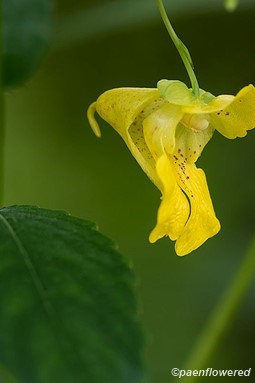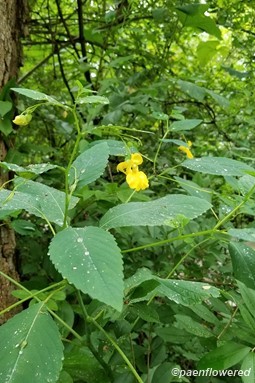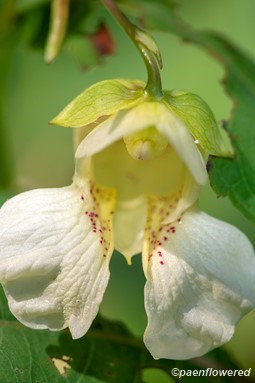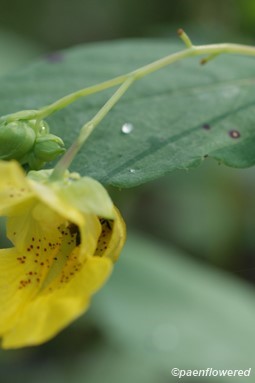Impatiens pallida
A plant of moist woods with yellow jewel-like flowers
Impatiens pallida pale jewelweed
If you touch or squeeze the fruit of this plant, when it is mature, it will explosively eject the seed. Thus it is not dangerous to touch but a bit of fun. This native annual wildflower is a member of the Balsaminaceae family of plants. It is common in much of Eastern and Central United States and Canada and common throughout Pennsylvania. It is a tall leafy plant with juicy, succulent, translucent stem and grows three to five feet high.
The 1 to 1 ½-inch flower is usually pale yellow with a few reddish-brown spots or splotches, especially on the lower lip. Three of the five petals form the two-lipped front of the flower, and one of the three sepals forms the rear calyx sac. These are fused or nearly fused. The calyx sac ends in a short downward-pointing nectar spur. Two petals form the upper lip of the flower. The other two sepals are pale green in color and rest on top of the flower. The flower is held in a horizontal position singly or in loose clusters from the leaf axils. The blooming period is June to October. Hummingbirds and bumblebees are attracted to the nectar in the spur and serve as the major pollinators. Bees must crawl inside the flower tube to reach the nectar.
The fruit is a fragile swollen five-chambered capsule that is capable of ejecting the seed some distance from the parent plant. The leaves are 1-4 inches long, thin, ovate and toothed. They are arranged in alternate fashion on the stem. The leaves are very delicate and often wilt during hot, dry weather. The plant grows mostly on the edges of shady wet woods and thickets, and often on hillsides. It prefers alkaline or neutral soils.
Juices from the plant are a traditional remedy for skin rashes, including poison ivy, insect bites, nettle stings and burns. The plant does contain a chemical called Lawsone that has anti-inflammatory and antihistamine effects, but human studies have either shown that juices from the plant are at best as effective as ordinary soap. The amount of lawsone in the leaves also varies with the season. Thus soap-like chemicals (saponins) in the plant produce the occasional beneficial effect on the rash.
The plant can also be a source of an orange-yellow textile dye. The plant is also called the yellow jewelweed. It often grows near a related similar species, the spotted jewelweed. The leaves of yellow jewelweed are larger and more finely toothed, as well as flowers are larger in size than those of spotted jewelweed.
Habitat & Range
Grows in swamps, moist woods and stream banks.
Present throughout the state.
Range: Found in eastern and central United States and Canada.
| EMP: | FACW |
|---|---|
| NCNE: | FACW |
Phenology
Flowers May to October.
Characteristics
Flowers pale yellow with a short abruptly bent spur
Plant Codes
S-rank: S5 (Secure)
G-rank: G5 (Secure)








Comments
Have you spotted this plant in your area? We'd love to hear about your experience! Share your comments or questions about the plant below. Comments are moderated before posting.